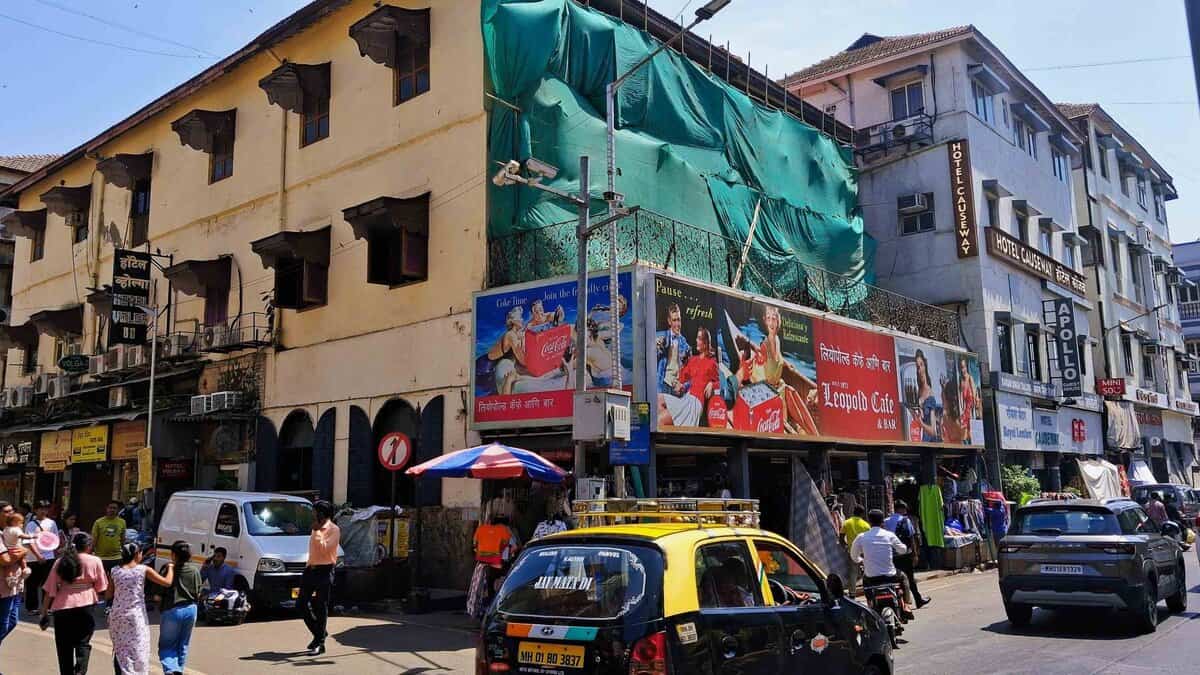
Touted as the oldest café in India, Leopold Café sits snugly within the labyrinthine streets of Mumbai’s Colaba Causeway. Here, history whispers through colonial-era buildings, and modernity pulses through swarming crowds. Located in the shadow of Mumbai’s magnificent twin landmarks—the Taj Mahal Palace Hotel (1903) and Taj Mahal Tower (1973)—Leopold, fondly called “Leo” by its loyal patrons, is more than just a café; it’s a landmark of nostalgia, resilience, and culinary brilliance.

Lavishly adorned with vintage artifacts, posters, and old-world charm, Leopold Café and Restaurant is always abuzz with people of all shades and shapes, eager to taste the thunder of yesteryears. Photograph and caption by N. Shiva Kumar
The café is compact, almost nondescriptive from the outside and open on both sides to the street. It is deliciously noisy inside, with cacophony from honking traffic and symphony of lively chatter. With grand colonial interiors, a vibrant mix of travellers and locals, and air thick with aromas of coffee and sizzling platters, Leopold is a living testament to Mumbai’s spirited soul. But what makes it so iconic? To understand, we must wander through its 155-year history, explore key incidents that shaped it, and savour the dishes that keep its tables full every day. On a silent day, if you pause and listen, you might even catch the sea breeze or the faint echo of Arabian Sea waves nearby.
Seductive stroll into colonial past
Leopold is just 1,000 meters away from Mumbai’s Gateway of India abutting the sea waters, which was built to commemorate the 1911 visit of King George V and Queen Mary. But the Leopold Café was establisheda full forty years before in 1871 by enterprising Iranian immigrants. Passed down through generations, the café has always remained in the same family as a traditional outlet catering to the public at large.
What began as a modest eatery became a cherished institution. Once a gathering place for traders, loafers, and British officers during the Raj, it grew into a cultural touchstone. In pre-independence times, it was a hotspot for intellectuals, businessmen, and revolutionaries. Over time, it transformed from a simple Irani café into a full-fledged restaurant and bar. With stained-glass windows, colonial wooden furniture, and timeless charm, it balances old-world Bombay elegance with modern energy of Mumbai.
A tragic chapter in 2008
I first visited Leopold Café a year after the devastating 26/11 attacks in 2008 while on office work to Bombay. Leopold was among the first locations to be hit, leaving behind shattered glass, traumatized lives and bullet-riddled walls. But true to Mumbai’s resilient spirit, it reopened within days. Even today, bullet holes are preserved—a stark, powerful reminder of the night that shook the city, and the spirit that refused to crumble.The bullet holes are a tourist attraction today.
The magic of Leopold

Founded by Zoroastrian Iranis, Leopold evolved from a wholesale oil store to a pharmacy and, finally, to the iconic café and bar it is now. Its logo—an Achaemenid Persian Lion Rhyton—pays tribute to its Zoroastrian roots, and it’s named after King Leopold of Belgium. Leopold’s soul lies in its cuisine. It’s where flavours burst, portions are generous, and every dish tells a tasty tale. Tourists and locals alike come for more than history—they come for a culinary adventure blending Indian, Chinese, and Continental tastes.
Standouts include the Leopold Special Sizzler—juicy meat, veggies, and fries drenched in sauce—and the spicy Indo-Chinese Beef Chilly. Seafood fans swear by the Garlic Butter Prawns and classic Fish & Chips. Their iconic beer pitcher encourages long, lazy conversations, while Leopold’s Chocolate Ecstasy Cake wraps up the meal with a sweet punch. Its food with flair made for both comfort seekers and culinary explorers. I was even thrilled by the serving staff who good-naturedly explained the exotic, nonexotic and bestsellers dishes on the menu.
Why is Leopold so popular?

Leopold’s magnetism isn’t just history or food—it’s the feeling of belonging. It’s immortalized in Gregory David Roberts’ book titled Shantaram, making it a must-stop for travellers and readers alike. Even a Hollywood movie was attempted based on the book with Leopold Cafe as one of the main themes but COVID years were a deterrent. The café has become a sanctuary for expats, dreamers, and storytellers. For locals, it’s a familiar escape—where artists, executives, and students share tables, stories, and laughs. Many waiters have worked here for decades, offering service that’s both traditional and heartfelt. Around 50 staff keep this legacy alive, while souvenirs like T-shirts and mugs let patrons take home a slice of the legend. On all my previous six visits over the years, I gleefully purchased their branded t-shirts.
The legacy lives on
Through every high and low, Leopold Café remains a symbol of Mumbai’s enduring spirit. It isn’t just a restaurant—its living history, still sizzling. Just last month, while relishing a sizzler with a local friend, I found the warmth of the staff outshone even the food. The laughter, the aroma, the chatter—they’re intoxicating, richer than any postcard image of Bombay. So next time you’re in Mumbai (though I still prefer “Bombay” for its colourful contours and soulful sentiments), step into Leopold. Order a cold beer, bite into a sizzler, and soak in the buzz. You won’t just eat—you’ll become part of a story that’s been bubbling for over 150 years.

